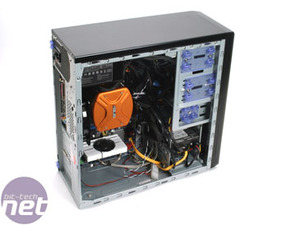Enermax Pandora Case
May 23, 2007 | 09:22

Opening Pandora's Box
Getting inside the case reveals a fairly standard case design. A HDD cage in the bottom right of the case is secured in with a single thumb screw, with a fan and air filter in front of it to keep the hard drives cool.Above the removable cage is room for two 3.5" drives and four optical drives, all of which are installed railessly and secured in place with plastic knobs.
Other than that the case is fairly standard. Both side panels can be removed and there is a gap between where the motherboard is mounted and the right-hand panel, which means that cables can be handily routed behind the motherboard to keep them out of the way and help facilitate the air flow throughout the chassis.
One thing we did notice as we went over the inside of the case with a fine toothed comb was how securely some of the removable sections, such as the I/O plate and the drive covers on the back of the case, were fastened in.
"Well, good!" we said at first, hoping that this was a positive indication of the build quality. When we had a closer look at them later though, we decided the opposite. Removing the drive covers or the I/O plate required so much force in the end that we resorted to just hammering them with the butt of a screwdriver in order to get them out.
Parts of the case have sharp edges too, such as around where the PSU would sit, which buyers should be wary of, though the more pressing issue is that the there is so little room around the PSU that careful thought must be given as to in which order the system is installed. Foolishly we mounted the motherboard and heatsink first, which meant we had to struggle to squeeze the PSU in above the enormous Asus Silent Square Pro we use in testing, as well as removing the side duct that funnels air out through one of the side grilles.
Hot and Sweaty
We put all the cases we get in through the same testing sequence, using the same hardware, to make sure that we get reliable responses to indicate how a case performs under stress from heat, as well as to make sure how easy it is to install and run a system on a case.For the Pandora, we used the standard heat-test system:
CPU: Intel Pentium XE 955 (dual-core, 3.46GHz with Asus Silent Square Pro heatsink)
Graphics Card: Sapphire Radeon X1600 XT Ultimate
Motherboard: Asus P5WD2-E Premium
RAM: 2x 512MB Corsair XMS2 DDR2-667
Optical drive: Sony CD-RW Drive
Hard-Drive: 1x 250GB Hard drive
We then started up our digital thermometer and then jumped right in.

MSI MPG Velox 100R Chassis Review
October 14 2021 | 15:04












Want to comment? Please log in.